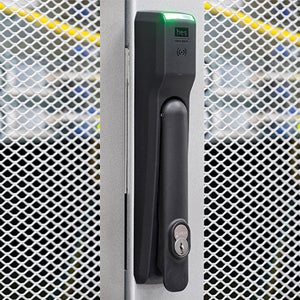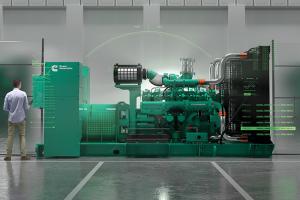Access control devices offer security solutions

Access control devices such as locks, door alarms, and entry and egress tools are designed to help health care facilities meet tough security challenges. As they have evolved, these devices have become part of systems that offer a way to centrally control doors, exits, entrances and ID badges.
Increasingly, today’s access control solutions are integrated with other security and nonsecurity systems such as human resources software, identity management and video surveillance, all of which provide information that can help to mitigate a potential crisis. They offer users a single-control platform to monitor specific locations in real time, particularly during emergencies to pinpoint and access event status and aid first responders.
By their nature, hospitals are open-
access buildings that pose challenges to manufacturers that supply these systems. In response, security teams are incorporating access-control solutions that restrict and control access into specific areas, in addition to solutions that manage keys and secure other assets.
“Hospital administrators are welcoming a series of new access-control technologies that can manage systems across multiple facilities and platforms,” says James Duff, a marketing communications manager at dormakaba Group.
Areas of demand
All areas of a hospital require a solid security system but, in particular, hospital emergency departments, maternity wards, intensive care units and pharmacies are seeing a greater demand for security devices because of the types of patients and high-value items that they house, experts agree. Those areas are employing access-control devices such as locks, ID cards, entry devices and door alarms to ensure that only medical personnel and approved visitors gain entry.
Because research has shown that quiet, relaxing spaces can improve health care outcomes, more hospitals are focusing on the aesthetic components of their facilities. “We are seeing more requests from inpatient areas for security options that are extremely quiet. This requires a total door-security solution that provides access-control components and door hardware and locks that are as silent as possible, as well as acoustic doors and frames that keep out unwanted sounds,” says Peter Boriskin, vice president of commercial product management, Assa Abloy Americas, New Haven, Conn.
Also, operational changes to a facility can greatly enhance the patient experience if it reduces or streamlines a process that might be seen as burdensome. “For example, we have seen cabinet locks being used for medicine cabinets within exam rooms, which allow staff to distribute medicines from the hallway into a secure pass-through cabinet. This prevents any disturbance while keeping medications safely under lock and key,” Boriskin adds.
Latest introductions
When properly selected and deployed, access-control equipment can play a vital role in enhancing safety and security that involve prescription and controlled medications, physical security, wandering patients, infant abductions, behavioral concerns, visitor management and other issues.
Among the latest introductions to the health care market, the Control Trim series from Securitech Group Inc., Maspeth, N.Y., features the ability to add electric release to doors with mortise locks, cylindrical locks or exit devices, without violating life-safety codes or adding magnetic locks. “By burying the electric release in the exterior trim, and adding request-to-exit signals to the interior lever movement, single-motion egress is possible. Electric release can be 24v DC, 12v DC or Power over Ethernet (PoE),” says Mark Berger, president.
Detex Corp., New Braunfels, Texas, has introduced a delayed egress with latch-retraction option, which is designed for applications in which delayed egress and remote unlocking, remote dogging, access control or automatic operation is desired. An exit switch may be added for push-pad monitoring or a switch for latch-bolt monitoring. “The 100-decibel alarm in the remote interface module will sound when someone attempts to exit. As it continues to sound, the door will remain locked for 15 seconds, which deters the unauthorized exit and gives the responsible party time to respond,” says Tim Shafer, sales and marketing manager.
Assa Abloy Americas has introduced the HES K200 lock, which brings access control to areas where audit trail and monitoring have become critical. The lock uses Wiegand communication between the integrated reader and an access control system to deliver full access control to cabinets and drawers, according to Boriskin. This enables real-time auditing capabilities and door monitoring at the drawer or cabinet level, he says.
Assa Abloy Americas also offers the Yale Accentra cloud-based platform, which is suitable for assisted-living facilities. The system works well in these environments because it allows administrators to manage access for residents, guests or staff from any internet-connected device, providing a high level of security and convenience. “With off-site facilities, you want to make sure the system is always accessible and that the manager can distribute on-demand credentials in the event of a lockout or lost card,” Boriskin says. “Having the ability to locally and remotely manage that is a huge operational advantage.”
The Keyscan system from dormakaba Group provides hardware and software solutions that anchor a networked access control system, but are designed to integrate with other physical security systems as well as third-party software platforms. The result is a single, integrated platform across all areas and facilities.
As part of this solution, dormakaba Group offers an Aurora software development kit, which allows health care information technology administrators to create custom integrations using their proprietary or existing software platforms. “One health care facility interconnects [its] Keyscan system with [its] infant abduction-prevention program,” Duff says. “When an infant is brought close to any exit, the system triggers an alarm. The area is immediately locked down until first responders arrive.”
Axis Communications Inc., Chelmsford, Mass., has developed the Axis A1001 network door controller, which allows facilities to mix and match the best hardware and software and to integrate them with other systems, including their existing surveillance systems. The solution supports PoE and has built-in door-controller software. Applications range from basic identification and entry control to advanced access management.
Galaxy Controls Systems, Walkersville, Md., recently introduced Cloud Concierge, a cloud-based access control and monitoring solution that provides real-time management of a health care facility’s access control system from any location using a PC, tablet or mobile phone. It provides centralized control for security personnel to search, enroll and maintain cardholders as well as set access privileges, according to Rick Caruthers, executive vice president.
The SiPass integrated access control solution from Siemens Building Technologies Div., Buffalo Grove, Ill., provides secure access to door-security devices and alarm points. It allows authorized individuals within the health care facility to give access to specific individuals or groups and to quickly revoke those access or alarm-code privileges through a central station operator or remotely via a secure login. “The system utilizes secure network protocols, thus preventing hackers from penetrating the IT network,” says Tom Komola, business development manager.
IoT evolution
The internet of things (IoT) continues to play a big role in the evolving world of hospital access control. “The IoT enables security personnel to control access to hospital areas remotely, and that includes managing keys. Dedicated PC-based, key-management software that can be remotely managed controls all programming, authorizations, remote functions and reports for the key-control system. Notifications and events can be automatically sent to authorized personnel, and built-in schedulers can be programmed to automatically download all data,” says Fernando Pires, CEO of Morse Watchmans Inc., Oxford, Conn.
The IoT plays a big role in today’s physical security ecosystem, which is made up of internet protocol-based video surveillance and physical access-control devices such as security cameras and door controllers, according to Paul Baratta, business development manager, health care, Axis Communications Inc. “With the industry focused on connected devices, Axis continues to look at the IoT as a tool to develop more sophisticated security solutions,” he says. “Today’s open standards allow previously separate device categories to be used together and accessed via a single management console, making systems easier to use while providing better situational awareness and overviews of incidents.”
Another potential application is the integration of access control and video-surveillance systems with facial recognition technology to verify that people using credentials to enter a health care facility are who they say they are. “The IoT also can be used to monitor traffic through exits and entry points to give hospitals security data on the effectiveness of their access control, as well as gather information following a security incident,” Caruthers says.
As health care facilities continue to grow, many are making advances in medical research, which brings about greater security concerns involving irradiation, chemicals, pharmaceuticals and biohazards. “They require a higher level of security that includes card access, biometrics or a combination of both,” Komola says. “Most of these facilities are federally regulated and inspected, so they often require radiation/chemical-detection systems with associated smart video.”
Siemens’ Siveillance Viewpoint PSIM (physical security information management) and Siveillance VMS (video management software) solutions are designed to protect those assets. “They can detect and time-stamp an event, bring into view associated video and commence the required protocols needed to reduce or eliminate any harmful effects from these alarm events. The protocols also can be viewed by a variety of personnel who can be notified of the event through Siemens’ Desigo mass notification system,” Komola adds.
A cloud-based future?
Among the advances manufacturers see for hospital access control systems in the near future, Caruthers predicts that the emergence of access control as a service (ACaaS) as a cloud-based offering will bring new, even higher, levels of service and capabilities into the field.
ACaaS not only provides accessibility, but also allows for cost sharing and shifting up-front capital costs into lower monthly operational expenses, he says.
Neal Lorenzi is a freelance writer based in Mundelein, Ill.

Lock down
The HES KS200 Integrated Wiegand server cabinet lock provides a layer of physical security to protect sensitive data at health care facilities. Assa Abloy Americas

Under control
This network door controller is an IP-based access-management system suitable for helping to keep people and assets safe. Axis Communications Inc.

Limited access
Keyscan access control systems use Aurora software to set specific functionality and access privileges. dormakaba Group

Key solution
KeyWatcher Touch offers easy-to-use key management in a modular and scalable design. Morse Watchmans Inc.

Secured entry
SiPass integrated access control solution provides secure access to door-security devices and alarm points. Siemens Building Technologies Div.

Built for safety
Heavy-duty exit devices are engineered for high-use and high-abuse, life-safety and security-door hardware applications. Detex Corp.

Easy upgrade
Control Trim adds electric release to doors with mortise locks, cylindrical locks or exit devices without violating life-safety codes or adding magnetic locks. Securitech Group Inc.

At your service
Cloud Concierge offers end users a turnkey, cloud-based, fully hosted and managed access control and monitoring solution. Galaxy Controls Systems




